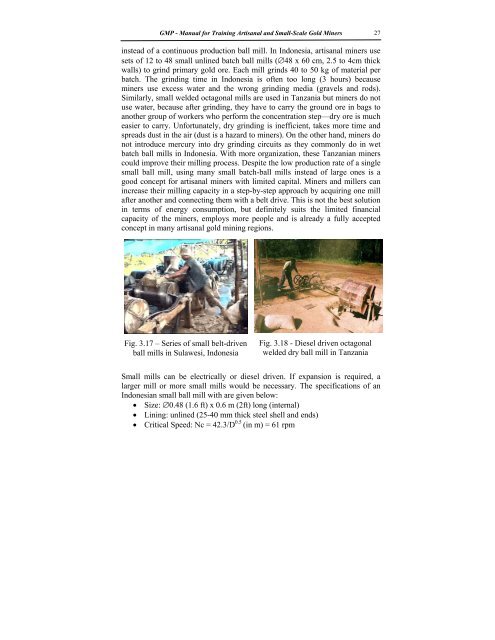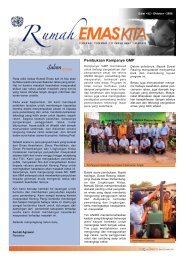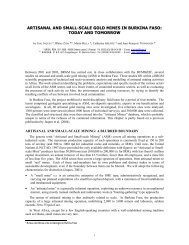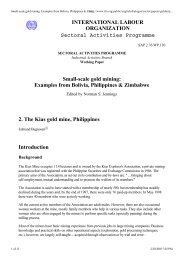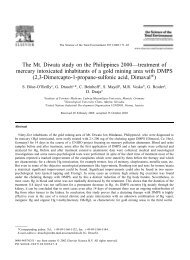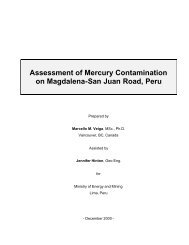Manual for Training Artisanal and Small-Scale Gold Miners
Manual for Training Artisanal and Small-Scale Gold Miners
Manual for Training Artisanal and Small-Scale Gold Miners
You also want an ePaper? Increase the reach of your titles
YUMPU automatically turns print PDFs into web optimized ePapers that Google loves.
GMP - <strong>Manual</strong> <strong>for</strong> <strong>Training</strong> <strong>Artisanal</strong> <strong>and</strong> <strong>Small</strong>-<strong>Scale</strong> <strong>Gold</strong> <strong>Miners</strong><br />
instead of a continuous production ball mill. In Indonesia, artisanal miners use<br />
sets of 12 to 48 small unlined batch ball mills (∅48 x 60 cm, 2.5 to 4cm thick<br />
walls) to grind primary gold ore. Each mill grinds 40 to 50 kg of material per<br />
batch. The grinding time in Indonesia is often too long (3 hours) because<br />
miners use excess water <strong>and</strong> the wrong grinding media (gravels <strong>and</strong> rods).<br />
Similarly, small welded octagonal mills are used in Tanzania but miners do not<br />
use water, because after grinding, they have to carry the ground ore in bags to<br />
another group of workers who per<strong>for</strong>m the concentration step—dry ore is much<br />
easier to carry. Un<strong>for</strong>tunately, dry grinding is inefficient, takes more time <strong>and</strong><br />
spreads dust in the air (dust is a hazard to miners). On the other h<strong>and</strong>, miners do<br />
not introduce mercury into dry grinding circuits as they commonly do in wet<br />
batch ball mills in Indonesia. With more organization, these Tanzanian miners<br />
could improve their milling process. Despite the low production rate of a single<br />
small ball mill, using many small batch-ball mills instead of large ones is a<br />
good concept <strong>for</strong> artisanal miners with limited capital. <strong>Miners</strong> <strong>and</strong> millers can<br />
increase their milling capacity in a step-by-step approach by acquiring one mill<br />
after another <strong>and</strong> connecting them with a belt drive. This is not the best solution<br />
in terms of energy consumption, but definitely suits the limited financial<br />
capacity of the miners, employs more people <strong>and</strong> is already a fully accepted<br />
concept in many artisanal gold mining regions.<br />
Fig. 3.17 – Series of small belt-driven<br />
ball mills in Sulawesi, Indonesia<br />
Fig. 3.18 - Diesel driven octagonal<br />
welded dry ball mill in Tanzania<br />
<strong>Small</strong> mills can be electrically or diesel driven. If expansion is required, a<br />
larger mill or more small mills would be necessary. The specifications of an<br />
Indonesian small ball mill with are given below:<br />
• Size: ∅0.48 (1.6 ft) x 0.6 m (2ft) long (internal)<br />
• Lining: unlined (25-40 mm thick steel shell <strong>and</strong> ends)<br />
• Critical Speed: Nc = 42.3/D 0.5 (in m) = 61 rpm<br />
27


